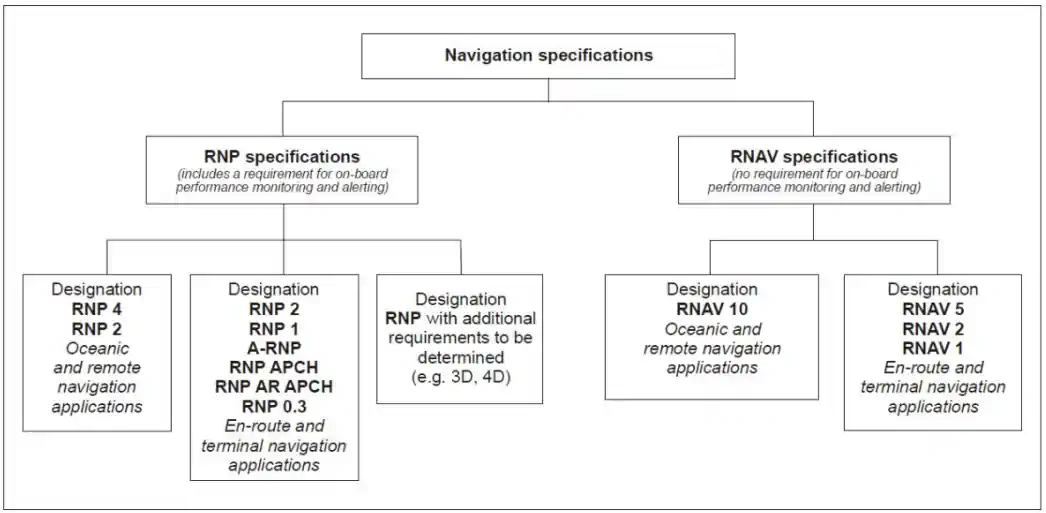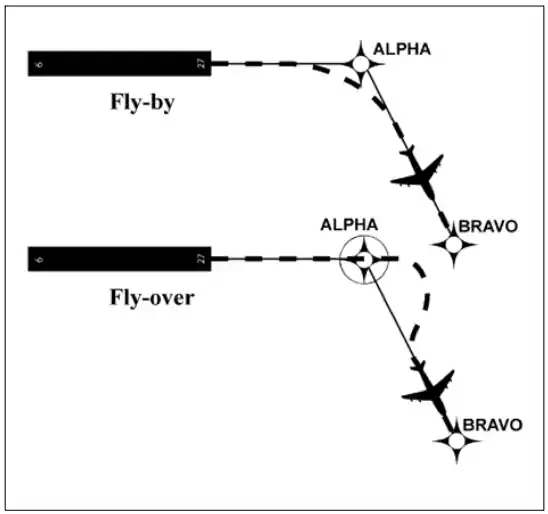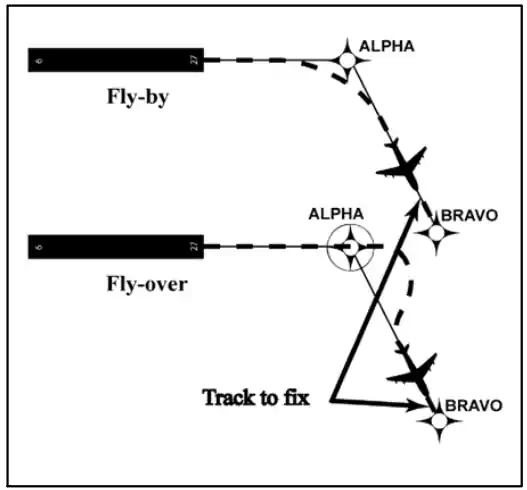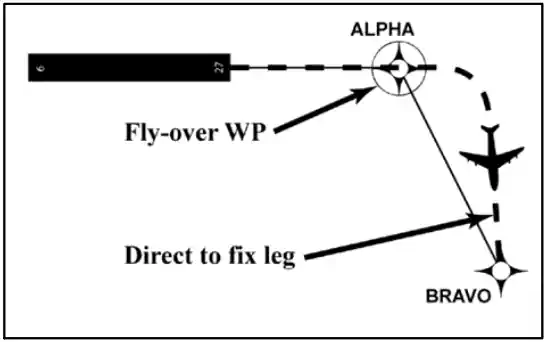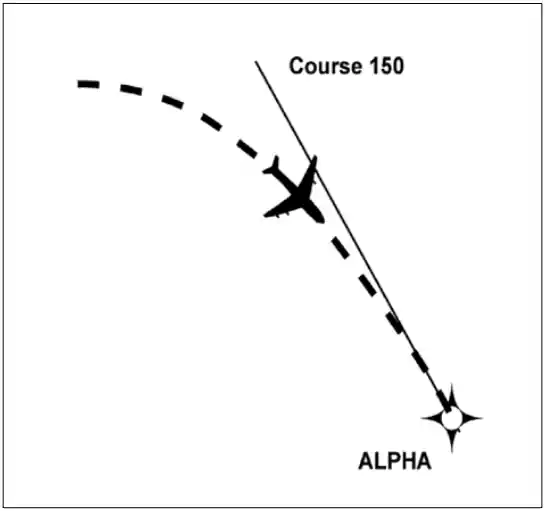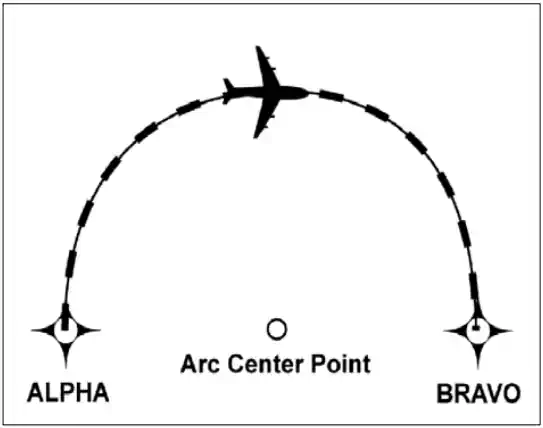Area Navigation
Area Navigation (RNAV) permits aircraft operation on any desired flight path within the coverage of ground or space-based navigation aids.
Introduction
Introduction
- As air travel has evolved, methods of navigation have improved to give operators more flexibility
- PBN exists under the umbrella of area navigation (RNAV) [Figure 1]
- The term RNAV in this context, as in procedure titles, just means "area navigation," regardless of the equipment capability of the aircraft
- Many operators have upgraded their systems to obtain the benefits of PBN
- Within PBN there are two main categories of navigation methods:
Area navigation (RNAV):
- In this context, the term RNAV "x" means a specific navigation specification with a specified lateral accuracy value
- For an aircraft to meet the requirements of PBN, a specified RNAV or RNP accuracy must be met 95 percent of the flight time
Required navigation performance (RNP):
- RNP is an RNAV system that includes onboard performance monitoring and alerting capability (for example, Receiver Autonomous Integrity Monitoring (RAIM))
- PBN also introduces the concept of navigation specifications (Nav Specs) which are a set of aircraft and aircrew requirements needed to support a navigation application within a defined airspace concept
- For both RNP and RNAV NavSpecs, the numerical designation refers to the lateral navigation accuracy in nautical miles which is expected to be achieved at least 95 percent of the flight time by the population of aircraft operating within the airspace, route, or procedure
- This information is detailed in International Civil Aviation Organization's (ICAO) Doc 9613, Performance-based Navigation (PBN) Manual and the latest FAA AC 90-105, Approval Guidance for RNP Operations and Barometric Vertical Navigation in the U.S. National Airspace System and in Remote and Oceanic Airspace
Pilots and Air Traffic Controllers Recognizing Interference or Spoofing
Pilots and Air Traffic Controllers Recognizing Interference or Spoofing
- The low−strength data transmission signals from GPS satellites are vulnerable to various anomalies that can significantly reduce the reliability of the navigation signal. The GPS signal is vulnerable and has many uses in aviation (e.g., communication, navigation, surveillance, safety systems and automation); therefore, pilots must place additional emphasis on closely monitoring aircraft equipment performance for any anomalies and promptly inform Air Traffic Control (ATC) of any apparent GPS degradation. Pilots should also be prepared to operate without GPS navigation systems.
- GPS signals are vulnerable to intentional and unintentional interference from a wide variety of sources, including radars, microwave links, ionosphere effects, solar activity, multi-path error, satellite communications, GPS repeaters, and even some systems onboard the aircraft. In general, these types of unintentional interference are localized and intermittent. Of greater and growing concern is the intentional and unauthorized interference of GPS signals by persons using "jammers" or "spoofers" to disrupt air navigation by interfering with the reception of valid satellite signals
- The U.S. government regularly conducts GPS tests, training activities, and exercises that interfere with GPS signals. These events are geographically limited, coordinated, scheduled, and advertised via GPS and/or WAAS NOTAMS. Operators of GPS aircraft should always check for GPS and/or WAAS NOTAMS for their route of flight
- c. Manufacturers, operators, and air traffic controllers should be aware of the general impacts of GPS jamming and/or spoofing, which include, but are not limited to:
- Inability to use GPS for navigation.
- Inability to use hybrid GPS inertial systems for navigation.
- Loss of, or degraded, performance−based navigation (PBN) capability (e.g., inability to fly required navigation performance (RNP) procedures).
- Unreliable triggering of Terrain Awareness and Warning Systems (TAWS).
- Inaccurate aircraft position on navigation display (e.g., moving map and electronic flight bag).
- Loss of, or erroneous, Automatic Dependent Surveillance-Broadcast (ADS−B) outputs.
- Unexpected effects when navigating with conventional NAVAIDS (e.g., if the aircraft is spoofed from the intended flight path, autotuning will not select the nearby NAVAID).
- Unanticipated position-dependent flight management system effects (e.g., erroneous insufficient fuel indication).
- Failure or degradation of Air Traffic Management (ATM) infrastructure and its associated systems reliant on GPS, resulting in potential airspace infringements and/or route deviations.
- Failure of, or erroneous aircraft clocks (resulting in inability to log on to Controller-Pilot Data Link Communications CPDLC).
- Erroneous wind and ground speed indications.
- When flying IFR, pilots should have additional navigation equipment for their intended route to crosscheck their position. Routine checks of position against VOR or DME information, for example, could help detect a compromised GPS signal. Pilots transitioning to VOR navigation in response to GPS anomalies should refer to the Chart Supplement U.S. to identify airports with available conventional approaches associated with the VOR Minimum Operational Network (MON) program. (Reference AIM 1-1-3f)
- Prior to departure, the FAA recommends operators to:
- Be aware of potential risk locations.
- Check for any relevant Notices to Air Missions (NOTAMs).
- Plan fuel contingencies.
- Plan to use conventional NAVAIDs and appropriate arrival/approach procedures at the destination.
- Follow the detailed guidance from the respective Original Equipment Manufacturer (OEM).
- During flight, the FAA recommends operators do the following:
- 1. Be vigilant for any indication that the aircraft’s GPS is disrupted by reviewing the manufacturer’s guidance for that specific aircraft type and avionics equipage. Verify the aircraft position by means of conventional NAVAIDs, when available. Indications of jamming and/or spoofing may include:
- Changes in actual navigation performance.
- Aircraft clock changes (e.g., incorrect time).
- Incorrect Flight Management System (FMS) position.
- Large shift in displayed GPS position.
- Primary Flight Display (PFD)/Navigation Display (ND) warnings about position error.
- Other aircraft reporting clock issues, position errors, or requesting vectors.
- Assess operational risks and limitations linked to the loss of GPS capability, including any on−board systems requiring inputs from a GPS signal.
- Ensure NAVAIDs critical to the operation for the intended route/approach are available.
- Remain prepared to revert to conventional instrument flight procedures.
- Promptly notify ATC if they experience GPS anomalies. Pilots should not inform ATC of GPS jamming and/or spoofing when flying through known NOTAMed testing areas unless they require ATC assistance. (See paragraph 1−1−13).
- 1. Be vigilant for any indication that the aircraft’s GPS is disrupted by reviewing the manufacturer’s guidance for that specific aircraft type and avionics equipage. Verify the aircraft position by means of conventional NAVAIDs, when available. Indications of jamming and/or spoofing may include:
- Post flight, the FAA recommends operators to:
- Document any GPS jamming and/or spoofing in the maintenance log to ensure all faults are cleared.
- File a detailed report at the reporting site: Report a GPS Anomaly Federal Aviation Administration, www.faa.gov/air_traffic/nas/gps_reports.
- For more information, check out this GNSS Intentional Administration Interference and Spoofing report
Conclusion
Conclusion
- Remember, the FAA requests user reports on NAVAID outages
- Still looking for something? Continue searching:
References
References
- Federal Aviation Administration - Pilot/Controller Glossary
- Aeronautical Information Manual (1-1-17) Global Positioning System
- Aeronautical Information Manual (1-1-18) Wide Area Augmentation System (WAAS)
- Aeronautical Information Manual (1-2-1) General
- Aeronautical Information Manual (1-2-3) Use of Suitable Area Navigation (RNAV) Systems on Conventional Procedures and Routes
- GPS.Gov
